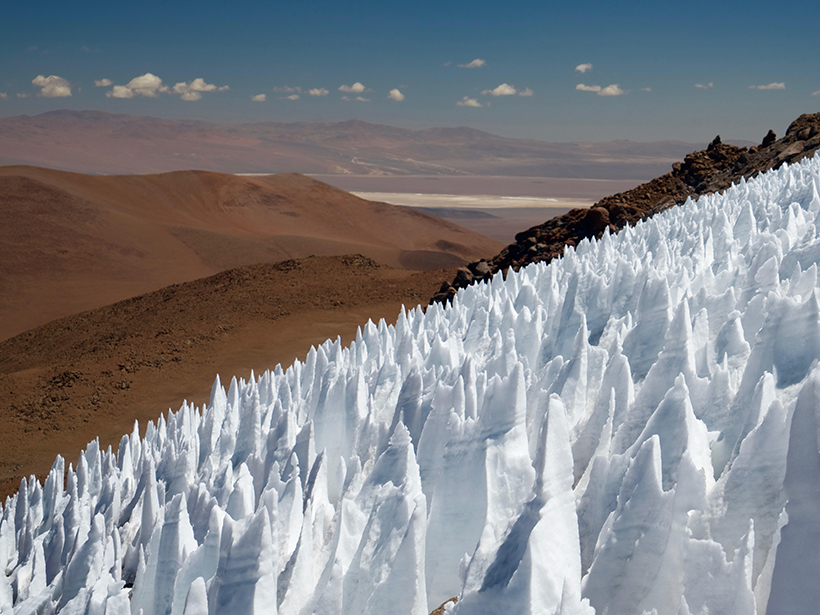The concept of blades of ice sculpted by the Sun sounds otherworldly, and it is. Such blades have been detected on Pluto and are believed to exist on Jupiter’s moon Europa. But they also form high in the Andes mountains of South America.
Now researchers have spotted microbial life on the earthly versions of these icy spires. This discovery has astrobiological implications, the science team behind it suggests: Ice might provide a toehold for life in the solar system.
“What’s This?”
Steve Schmidt, a microbial ecologist at the University of Colorado Boulder, and his colleagues didn’t set out to study penitentes, which form when sunlight strikes patches of snow, causing it to sublimate. (The features’ Spanish name refers to their resemblance to white-robed monks doing penance.) In March 2016, Schmidt and his team were hiking up Llullaillaco, a dormant stratovolcano on the border between Chile and Argentina, and paused to rest at an elevation of roughly 5,300 meters near a field of penitentes. Schmidt remembers a team member seeing pinkish red smudges on roughly meter tall penitentes and asking, “What’s this?”
The smudges looked biological, but they were also rare: Only about 0.1% of the penitentes in the field had any coloration, Schmidt said. “You could easily walk by and not see it.”
The scientists weren’t planning to sample the penitentes, but seeing the unusual color piqued their interest. They retrieved sterile spoons from their packs and, over the course of a few hours, collected five samples of the pinkish red ice from the sides of several penitentes and the “wells” between them.
Snow Algae
Back in the laboratory at the University of Colorado Boulder, the researchers analyzed the samples’ DNA.
By comparing the samples’ DNA sequences with sequences from known organisms, the scientists found a perfect match with strains of the snow algae Chlamydomonas nivalis taken from Mount Kilimanjaro, the Swiss Alps, and Antarctica. But not all of the DNA from the penitentes matched Chlamydomonas nivalis—some probably came from previously unknown species of snow algae belonging to another genus, Chloromonas, and perhaps even other unknown genera, the team concluded.
“I think it’s the first discovery of microbes on penitentes,” said Schmidt. “Nobody ever thought to look for them.” These results were published in June in Arctic, Antarctic, and Alpine Research.
Sunscreen for Algae
“It’s sort of a sunscreen for the algae.”
The red coloration of the snow algae is more than just eye-catching—it likely helps protect the algae from the intense sunlight that blasts the upper reaches of Llullaillaco, said Schmidt. Red-hued pigments like carotenoids within red varieties of snow algae—such as Chlamydomonas nivalis—dissipate the Sun’s energy by radiating away heat.
“It’s sort of a sunscreen for the algae,” said Schmidt.
By reemitting the Sun’s radiation, snow algae also warm up their surroundings and melt the ice around them to create liquid water.
“You have this oasis where there’s abundant life,” said Schmidt.
John Moores, a planetary scientist at York University in Toronto, Canada, not involved in the research, agrees. “The environment within the small-scale nooks and crannies of those exposures could be more clement from an astrobiological perspective than the surface more broadly.”
Snow algae might also play a role in the formation of Llullaillaco’s penitentes, researchers suggest. Previous results have shown that snow algae can have the same effect as dusty debris on a snowy surface, absorbing more sunlight than bare snow alone.
By kick-starting sublimation, snow algae may contribute to the formation of penitentes, Schmidt and his team hypothesized. An important next step will be determining whether snow algae are present during different phases of penitente growth, the researchers concluded.
Limits of Life
Earthly penitentes harbor life, Schmidt and his team showed, but what about extraterrestrial penitentes? These features have been spotted on Pluto, where they’re composed of nitrogen and methane rather than water, and are inferred to exist on Jupiter’s moon Europa.
To help answer that question, Schmidt and his colleagues want to understand the environmental limits of microbes like snow algae. Penitentes can be found all the way up to the top of Llullaillaco, the second-highest active volcano in the world (6,739 meters). Conditions get progressively harsher near the summit, and Schmidt and his team want to return to South America to look for microbes at a range of elevations.
That’ll help answer just how much ultraviolet radiation and aridity life can handle, said Schmidt. “At what elevation can you not find them?”
—Katherine Kornei (@katherinekornei), Freelance Science Journalist
Citation:
Kornei, K. (2019), Microbes spotted on blades of ice high in the Andes, Eos, 100, https://doi.org/10.1029/2019EO130463. Published on 15 August 2019.
Text © 2019. The authors. CC BY-NC-ND 3.0
Except where otherwise noted, images are subject to copyright. Any reuse without express permission from the copyright owner is prohibited.

